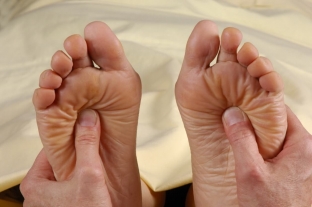Diabetes mellitus is a fairly common pathology that affects the vascular system, nervous system, organs of vision and excretion. Diabetes is not considered a disease, but a special & nbsp; way of life that changes significantly. First of all, this is due to complications of diabetes mellitus, which include diabetic neuropathy.
Diabetic neuropathy in type 1 diabetes mellitus begins to manifest itself 5 years after the onset of the disease in 10% of patients. Diabetic neuropathy is a combination of syndromes affecting the nervous system.
Types and causes of diabetic neuropathy
There are three theories for the development of diabetic neuropathy. The first of them – activation of the polyol pathway of glucose metabolism, after which sorbitol and fructose accumulate in nerve cells, and the content of glutathione and myoinositol decreases. The second theory – angiopathy of small vessels provokes a slowdown in capillary blood flow and contributes to the development of hypoxia. The third theory - Non-enzymatic glycosylation of membrane and cytoplasmic proteins in cells of the nervous tissue
Diabetic neuropathy can be sensorimotor and autonomic. The severity of nerve cell damage is variable. Sensorimotor neuropathy may be focal (mononeuropathy) or polyfocal (proximal motor, cranial, motoneuropathy of limbs and trunk), and symmetrical. As for autonomic diabetic neuropathy, it manifests itself in many body systems.
Autonomic (vegetative) diabetic neuropathy has the following manifestations:
- Gastrointestinal (biliary dyskinesia, diabetic enteropathy, gastric atony).
- Cardiovascular (cardiac denervation syndrome, orthostatic hypotension).
- Urogenital (with impaired sexual function and bladder function).
- Impaired hypoglycemia recognition process.
- Impaired pupil function.
- Sweat gland dysfunction (hyperhidrosis, distal anhidrosis).
Main symptoms of diabetic neuropathy
The clinical course of diabetic neuropathy is most often represented by distal sensorimotor symmetrical neuropathy. The most characteristic symptom of the distal form of the lesion is paresthesia, manifested by numbness and a crawling sensation. At the same time, patients complain of a feeling of cold and chilliness in the legs. On palpation, the skin of the legs is warm. This makes it possible to distinguish ischemic changes in the limbs from neuropathy. With ischemic lesions against the background of impaired blood circulation, the legs will feel cold to the touch.

Sensory neuropathy begins to manifest itself as a violation of vibrational sensitivity. Sensory diabetic neuropathy is characterized by restless legs syndrome, which consists of a combination of nocturnal paresthesias and hypersensitivity. The pain in the legs increases at night, sometimes becoming intense, which does not allow to endure the touch of a blanket. In the presence of obliterating diseases of the arteries, pain in the leg may decrease when walking. After a few years, pain in the legs may go away on its own due to the death of small nerve cells of the nerve fibers that are responsible for pain sensitivity.
Manifestations of altered sensitivity in diabetic neuropathy
Hypoesthesia in diabetic neuropathy is manifested by a process of sensory disturbance in the form of "gloves"; and "stocking". Impaired proprioceptive deep sensitivity leads to the fact that coordination is disturbed and movement is difficult. In such conditions, people complain of a "feeling of standing on vata." Disturbed innervation provokes the appearance of degenerative changes in the skin, tendons and bones.
Patients with diabetic neuropathy often injure the feet, the wounds on which become infected. This occurs against the background of reduced pain sensitivity. Impaired coordination provokes an incorrect redistribution of the load on the joints of the foot. At the same time, the foot is deformed, a fracture, swelling and chronic purulent processes develop.
What are the symptoms of other forms of diabetic neuropathy?
The cardiovascular form develops when the innervation of the cardiovascular complex and large vessels is disturbed. The vagus nerve is the longest nerve, and therefore it is affected earlier than others. Against this background, sympathetic influence prevails and rest tachycardia develops.
The symptom of the gastrointestinal form of diabetic neuropathy is gastroparesis with rapid or delayed gastric emptying, the urogenital form is characterized by atony of the bladder and ureter, which leads to a tendency to urinary infections, erectile dysfunction, retrograde ejaculation.
Diabetic neuropathy is important to distinguish from neuropathies of other origins (uremic, alcoholic, B12 deficient). Treatment includes optimization of hypoglycemic therapy in combination with symptomatic therapy.







Add a comment